#tz'i
Explore tagged Tumblr posts
Note
Put simply, what determines how mayan glyphs are arranged?
Mainly appearance, though some glyphs are more common in secondary form (I forget the actual term for the skinnier glyphs on the edges of blocks), and others need to be the main glyph in a block.
Different scribes had different preferences. Some tried to keep individual words together in a block. Some gave more space to complex glyphs so they didn't have to make the details as tiny. (I avoid making 'tz'i' small. Too much work.) Some would emphasize important parts of the writing by giving it more space. Names usually get a lot more space the first time they show up, and are then compressed in later appearances. Some scribes used one glyph a block - either because they weren't comfortable enough with writing to play with it, or because they were using a special, extra fancy variant that turns each glyph into a full person who takes up their own block.
Glyphs that stand for full words are usually in the same block as their phonetic compliments (the glyphs that tell you their first or final sound).
Numbers and 'ʔu-' (which means 'they/it/he/she') are usually first in a block (at the left/top), and I've never seen 'ʔu-' alone. On the other hand, 'w-vowel', 'ni,' and 'TE' glyphs are usually in the final position (right or bottom).
Often, a set amount of space for the writing was decided beforehand, and scribes did their best to make the writing fill that space.
'ʔu-' means he/she/they/it, and I've never seen it on it's own, or in any non-initial position in a block. (It's always either the left side or the top.) Glyphs that stand for 'w-vowel,' 'ni,' and 'TE' are usually, but not always, in the last position (right side or bottom).
Reading order is from top left of a block down to the bottom right.
Glyphs that stand for full words are usually in the same block as their phonetic compliments (the glyphs that tell you their first or final sound).
While some scribes stack secondary glyphs, that isn't common. (Usually there aren't 2 skinny glyphs on the same side of a block.) Main glyphs are fine to stack, though, and having a secondary glyph on multiple sides is common. (Also, some secondary glyphs have half versions, so you can stick 2 together in the same spot.)
The amount of variation is breathtaking. Some monuments have glyph-blocks so big and complex that entire sentences fit in one. More casual writing on cave walls usually consists of 1-3 glyphs a block. And monuments can also have really simple blocks. It's up to the scribe.
-
On a larger scale, blocks of glyphs are USUALLY in horizontal pairs (left to right). These pairs can then be laid out in any order you want. The whole text can be horizontal, the pairs can be arranged vertically, they can start vertically down the side of an image, and then continue horizontally underneath it, etc.
You also get single columns, rather than pairs, and even glyphs being read from right to left.
-
In summary, it's mostly personal preference. Even glyphs that usually fit in a certain spot can be stretched/squished into another if the scribe really wants them to.
But once you figure out the writing style of the scribe (or your own writing style!) it's often possible to predict roughly how things will be laid out.
#classical maya#written maya#epigraphy#historical epigraphy#reminder that I am an amateur#and reading a lot isn't the same as getting taught#so there may be mistakes here
35 notes
·
View notes
Text

Buen día 10 TZ'I, 13 YAX de este año 12 N’OJ. 5,152, el día de la rectitud, de la integridad, del orden y la palabra de autoridad.
Atte: https://mayatecum.com/tiendamt/
0 notes
Text
Ancient Maya kingdom with pyramid discovered in southern Mexico
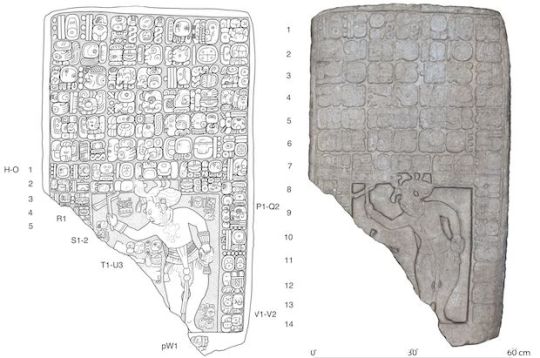
After searching for more than a quarter century, archaeologists may have finally located the capital city of Sak Tz'i', a Maya kingdom that's referenced in sculptures and inscriptions from across the ancient Maya world. But it wasn't archaeologists who made the find. A local man discovered a 2- by 4-foot (0.6 by 1.2 meters) tablet near Lacanja Tzeltal, a community in Chiapas, Mexico.
The tablet's inscriptions are a treasure trove of mythology, poetry and history that reflect the typical Maya practice of weaving together myth and reality. Various sections of the tablet contain inscriptions that recount a mythical water serpent, various unnamed gods, a mythic flood and accounts of the births, lives, and battles of ancient rulers, according to a news statement from Brandeis University in Massachusetts. Read more.
239 notes
·
View notes
Photo
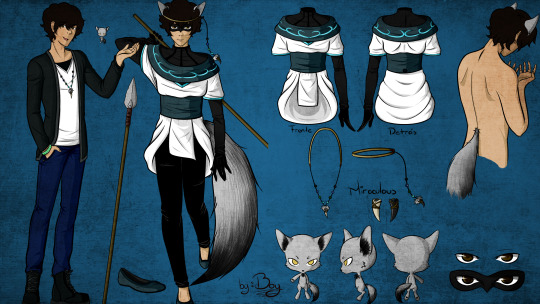
NOMBRE DEL SUPER HÉROE: “Nahual” El Hombre-Lobo Prehispánico.
Nombre de Civil: Noe Muñoz
Nombre del Kwami: TZ'I
ANIMAL DEL MIRACULOUS: Lobo mexicano.
OBJETO DEL MIRACULOUS:
Se trata de un diente de lobo que carga en un collar junto con un poco de pelaje del mismo animal adornado con cuatro pares de piedras preciosas típicas del territorio mexicano y que se usaban antiguamente en su día a día, de arriba hacia abajo son:
Ø Obsidiana, conocida como “Iztli”, es un cristal volcánico muy abundante en el territorio nacional y que fue objeto tanto de tributo como de intenso comercio. Relacionado con la verdad, el auto-conocimiento, poder personal, fuerza y protección.
Ø Lapislazulli, conocida comunmente como “Lapis”, palabra del latín que significa piedra, y “lazuli” que viene de un viejo termino árabe que significa paraíso, es la piedra de auto-ayuda, se cree que ayuda a clarificar nuestros pensamientos, al igual que un cristal para la comunicación.
Ø Jade, conocida como “Chalchihuitl”, el jade era la piedra de la creación, significaba vida, fertilidad y poder, tal vez la piedra más apreciada por las culturas mesoamericanas debido a la relación que se le atribuía con algunas deidades, al igual que el amor, curación, longevidad, sabiduría, protección, jardinería, prosperidad y el dinero.
Ø Turquesa, conocida como “Teoxihuitl” la hierba de los dioses. Piedra ampliamente usada en los trabajos de mosaico, relacionado con la protección, la alegría, el bienestar y la purificación.
Pero cuando se transforma, su collar se convierte a una diadema colocada lateralmente con solo una piedra preciosa en lugar del par, además el diente se vuelve a un color gris obscuro.
ARMA:
Se trata de una lanza arrojadiza, que consta de un hasta larga de 1.70 a 1.80 m. llamada “Tlazonctectli”, usada en combate cuerpo a cuerpo, así como para largo alcance, y defensa. Hecho a partir de una saeta de madera que puede ser arrojada con la fuerza del simple brazo aunque con una evidente baja potencia pero no sin dejar de ser letal.
Aunque no por tratarse de un arma antigua signifique que sea más débil que un arma de fuego, al contrario, es de un material muy resistente parecido a la madera y a la piedra, pero de una gran resistencia, además de ser muy liviano.
PODERES:
Al tratarse su Kwami de un lobo, sus principales habilidades están relacionadas con este animal, las cuales son: una gran resistencia y aguante físico. Puede trotar a una velocidad de 10 km/h y correr a 65 km/h. Posee de igual manera un extraordinario sentido del olfato y puede ver bien en situaciones con poca luz. Además de grandes habilidades reflejo.
Sus poderes, así como su nombre de super héroe lo indica, están relacionados con los nahuales. En todos los pueblos y ciudades en México se conoce a este ser como uno que es capaz de transformarse en animales (ya sea un lobo, jaguar, lince, toro, águila, coyote, etc.) La palabra Nahual significa para los aztecas “lo que es mi vestidura o piel”, y se refiere a la habilidad cambiante de este. Además ellos mismos creían que si un hombre podía llegar a conocer su espíritu primitivo o Nahual, en este caso el Kwami, entonces podría usar sus poderes y habilidades para curar gente y practicar magia.
“La Metamorfosis”:
Como poder especial y habilidad principal puede dejar su forma humana por un tiempo limitado, para adquirir la apariencia de un lobo. Esta transformación dura de 10 a 15 minutos, todo dependiendo del desgaste físico que sufra durante el uso de este.
O bien, en su defecto, en lugar de transformarse, pude modificar sus habilidades y cambiarlas por las de cualquier otro animal de su elección, pero con el único limitante de que debe tratarse de especies originarias de México. Por ejemplo cambiar todas las habilidades del lobo por las de un Águila Real Mexicana, las cuales son una visión es 8 veces más potente que la vista humana, siendo capaz de enfocar dos puntos al mismo tiempo: en uno mantiene una visión binocular y en el otro monocular. Esta capacidad les permite triangular su campo de visión y calcular la posición y distancia de los objetivos, ejercer una presión de 300 kg por cm² con sus manos y descender lentamente como si flotara en aire en lugar de volar.
DATOS EXTRA:
En muchas ocasiones, Nahual, al inicio, en lugar de ser recibido como un super héroe es tomado como un super villano, todo debido a su apariencia y habilidad de transformarse en lobo, ya que estos animales suelen a ser relacionarlos con la errónea visión de ser malvados y asesinos de sangre fría. Aunque en realidad los lobos son criaturas amistosas y sociales, así como él.
TZ'I
Es una pequeña criatura de color gris claro, con una gran cabeza y un cuerpo minúsculo. Tiene ojos pequeños y alargados de color avellana. Su cuerpo está recubierto de un pelaje suave, sus orejas son iguales a las del lobo mexicano, en su pecho sobresale una mota de pelaje gris obscuro, además, posee una larga y esponjosa cola de un progresivo degradado de color gris claro a gris obscuro.
Tz'i, además significa perro, secretario, escritura, autoridad, guardián de la ley material y espiritual. Representa la fidelidad, el orden y la exactitud. Es la energía guardiana de los cerros, las montañas, las veredas, los barrancos, la justicia, la vida material y espiritual desde el principio hasta el final. Es el Nahual de la sexualidad, la piedra del sol, la ceremonia para liberar la pobreza y los vicios. Es signo es de la ley y de la autoridad, tanto terrestre como cósmica, es la justicia y el día que trae a la luz la verdad.
ASPECTOS POSITIVOS DE SU PERSONA
Maneja los conocimientos de las leyes espirituales y materiales. Es muy noble y honrado. Practica y defiende la justicia social. Es alguien con mucha paz y fe espiritual. Además de ser muy amable y alegre. Es un detective y descubridor de grandes secretos por naturaleza (es muy inquisitivo), y es adorador de las fuerzas mediadoras entre hombres y seres espirituales. Por último es un ser bueno, justo y equilibrado.
ASPECTOS NEGATIVOS DE SU PERSONA
Quiere ser la máxima autoridad entre él y el portador del Miraculus. Siempre se rige por tus propios reglamentos y creencias. Suele, por esto, tener un carácter insoportable e irritable. Le gusta chismear y espiar. Tiende mucho al alcoholismo y tabaquismo. Es poco aceptado por sus allegados. Además de ser muy vengativo y destructivo. Por último, solo piensa en su placer y no le gusta que le critiquen.
Podría decirse que es un hippie irritable.
NOE MUÑOZ
Es un joven mexicano de 22 años. Estudio la carrera de artes plásticas, además de tomar cursos para volverse un guía de turistas de las zonas arqueológicas de todo México, por esta razón es alguien con un gran conocimiento cultural. Es moreno de tez clara, en comparación con la media, de ojos y cabello café obscuro. Su cabello además es rizado y muy alocado. Mide aproximadamente 1.70 m.
Su guardarropa costra de camisas claras con cuello en “v” las cuales lleva por encima de playeras con manga larga en caso de no llevar puesto un suéter o una chamarra. Sino, estas son sin mangas. Las playeras son de todas de colores obscuros contrastantes con las camisas. Todos los días usa jeans, ya sean azules que son de todas las tonalidades existentes o bien negros. Calza del 7. Consta solo con varios pares de botas militares y de converse de colores obscuros. Siempre lleva puesto el collar con el Miraculous que el mismo adorno con las piedras preciosas. Este, cuando no está activado, es de color beige y cuando si lo está, se vuelve de color gris obscuro.
Como Nahual, usa un traje inspirado en la combinación de las vestimentas tradicionales de las culturas prehispánicas y con las actuales del universo de Miraculous. Esto se nota mejoren la parte superior, que consta de una playera color gris obscuro que se va degradando hacia las puntas de las manos a color negro, estas mangas son tan largas que cubren incluso las manos, tal cual como las de Ladybug. Además esta es de cuello alto con contorno negro y del cual desprenden 3 líneas negras hacia el torso. Por encima de esta lleva un híbrido entre un huipil y una guayabera de color blanco, esta tiene un corte en “v” de contornos azul turquesa, que amarra con un manto de color azul plomo en el torso. Y sobre todo esto, lleva además un chal azul plomo con decoraciones azul turquesa.
Sus pantalones son parecidos a un par de mallas negras. Calza unas ballerinas del mismo azul plomo con suelas negras y muy resistentes.
Como adicional, tiene orejas de lobo de igual manera que las de Chat Noir, las cuales controla muy bien. Su cola es real y es una extensión de su columna vertebral, además es del mismo estilo, color y suavidad que la de Tz'i. Al llevar el antifaz gris obscuro, sus ojos se vuelven de color avellana brillante y sus pupilas cambian hasta asemejarse a los de un lobo. Su cabello no cambia, salvo que cubre sus orejas normales.
ASPECTOS POSITIVOS DE SU PERSONA
Es muy energético, entusiasta y alegre, le gusta mucho la historia de México y el arte, es muy responsable, educado y amable, no solo con las ruinas y tradiciones, sino también con todas las personas. No siente la necesidad de imponerse ante las personas y/o acontecimientos. Asiste a quien lo necesite. Sabe que es imposible bañarse dos veces en el mismo río, por esto se mantiene siempre libre y disponible. Es resistente al sueño. Desprende sensibilidad, además de dar fuerzas. Es expresivo, intuitivo, determinado y está al servicio de los demás para un propósito siempre alto. Es un joven muy creativo y entusiasta para la realizar obras de arte y para prestar servicios sociales. Por último, es muy franco y directo. No se expone ante nada a menos que se trate de terceras personas, porque allí se vuelve muy valiente.
ASPECTOS NEGATIVOS DE SU PERSONA
Es extremadamente sensible y nervioso. Por otro lado es muy obstinado y sarcástico. Es demasiado indeciso. Vive confundido por no saber si hacer caso omiso a las sensaciones e intuiciones internas que no lo dejan actuar con soltura. Se ofende con facilidad y cuando esto ocurre se deprime hasta llegar a extremos muy absurdos. Es de sensaciones bloqueadas, se apega con facilidad a las cosas y por eso le cuesta mucho deshacerse de ellas. Se frustra por eso muy seguido. Además se siente inferior e inseguro de él mismo. Cuando se desvela mucho tiempo se pone de nervios y sufre letargos muy fácilmente. Por último es enfermizo.
PORQUE LO ELEGÍ:
Soy de México, así que realmente no hay mucho secreto sobre mis gustos e inspiraciones. Me gustan mucho las culturas antiguas, no solo las mexicanas, sino también las del resto del mundo. Al igual que todos los mitos y leyendas, es por eso que elegí al Nahual como base para los poderes de mi personaje, además de que está presente en todas las culturas prehispánicas, es genial la forma en la que se desenvuelve todo su contexto como parte del universo de Miraculous. Además de que mi animal favorito es el lobo, y qué más que un lobo mexicano para crear a Tz'i como Kwami.
ENGLIS TEXT HERE x
Full image X
#miraculous ladybug#miraculous lady bug#mi miraculous#alfrely#nahual#tz'i#noe muñoz#oc#kwami#mexico#méxico#miraculous sona#miraculous oc#lobo#wolf#werewolf#my art#miraculousona
21 notes
·
View notes
Text
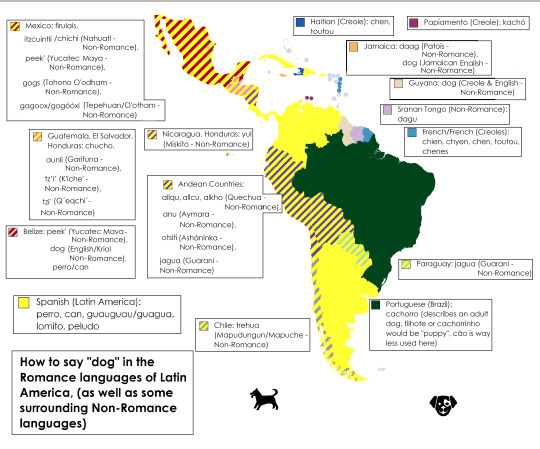
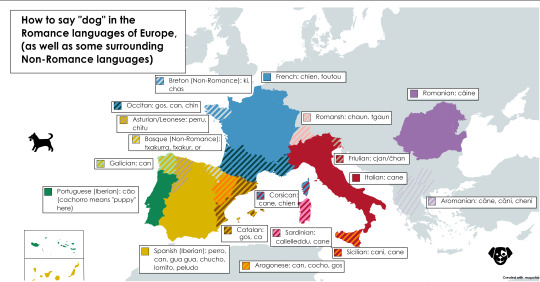
How to say "dog" in the Romance Languages of Europe and Latin America, as well as some surrounding Non-Romance Languages. 🐕🐶🐕
Words for “dog”:
Europe:
Spanish 🇪🇸🇮🇨: perro, can, gua gua, chucho, lomito, peludo
Asturian/Leonese 🇪🇸: perru, chitu
Basque 🇪🇸🇫🇷 (Non-Romance): txakurra, txakur, or
Portuguese 🇵🇹: cão (cachorro means "puppy' here)
Catalan 🇪🇸🇦🇩: gos, ca
Galician 🇪🇸: can
Aragonese 🇪🇸: can, cocho, gos
Occitan 🇫🇷: gos, can, chin
French 🇫🇷🇨🇭🇧🇪: chien, toutou
Breton 🇫🇷 (Non-Romance): ki, chas
Corsican 🇫🇷: cane, chien
Italian 🇮🇹🇨🇭: cane
Friulian 🇮🇹: cjan, čhan
Sicilian 🇮🇹: cani, cane
Sardinian 🇮🇹: callelleddu, cane
Romansh 🇨🇭: chaun, tgaun
Romanian 🇷🇴🇲🇩: câine
Aromanian 🇬🇷🇦🇱🇲🇰🇷🇴🇧🇬: cãne, cãni, cheli
Judaeo-Spanish/Ladino 🇧🇦🇪🇸🇬🇷🇹🇷🇮🇱🇫🇷🇵🇸🇲🇦🇪🇬🇷🇴🇲🇰🇷🇸🇦🇷🇵🇹🇧🇷🇭🇷🇺🇸🇮🇹🇩🇿🇲🇽: פירו (pyrw), cian
Latin America (& some of the Caribbean)
Spanish 🇨🇴🇨🇺🇲🇽🇵🇷🇸🇻🇩🇴🇨🇷🇨🇱🇵🇪🇬🇹🇵🇾🇦🇷🇺🇾🇪🇨🇧🇴🇻🇪🇳🇮🇭🇳🇵🇦: perro, can, guauguau/guagua, lomito, peludo
Portuguese 🇧🇷: cachorro (describes an adult dog, filhote or cachorrinho would be "puppy", cão is way less used in Brazil than in Portugal)
Haitian 🇭🇹 (Creole): chen, toutou
Papiamento 🇦🇼🇧🇶🇨🇼 (Creole): kachó
Jamaica 🇯🇲: daag (Patois, Non-Romance), dog (Jamaican English, Non-Romance)
Guyana 🇬🇾: dog (Creole & English, Non-Romance)
Sranan Tongo 🇸🇷 (Non-Romance): dagu
French/French 🇬🇫🇲🇶🇬🇵🇩🇲🇱🇨🇭🇹(Creoles): chien, chyen, chen, toutou, chenes
Mexico 🇲🇽: firulais
Nahuatl (Non-Romance): itzcuintli/chichi
Yucatec Maya (Non-Romance): peek'
Tohono O'odham (Non-Romance): gogs
Tepehuan/O'otham (Non-Romance): gagoox/gogóóxi
Guatemala, El Salvador, Honduras, Mexico 🇬🇹🇸🇻🇭🇳🇲🇽: chucho
Garifuna (Non-Romance): aunli
K’iche’ (Non-Romance): tz'i'
Q’eqchi’ (Non-Romance): tzi’
Miskito (Non-Romance): yul
Quechua (Non-Romance): allqu, allcu, alkho
Aymara (Non-Romance) anu
Asháninka (Non-Romance): otsiti
Guarani (Non-Romance): jagua
Kriol 🇧🇿 (Non-Romance): dog, daag
Mapudungun/Mapuche (Non-Romance): trehua
Zapotec (Non-Romance): Bi'cu', Beco'
Bribri (Non-Romance): chìchi
(Languages that are Indigenous to the Americas are flag-less in this list due to being older than these countries)
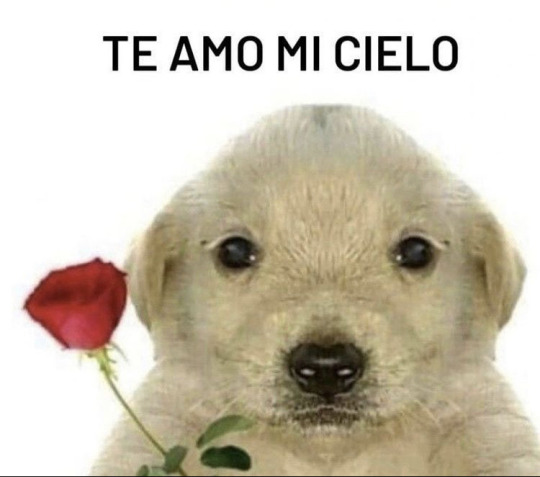
#map#maps#cartography#mexico#latin america#europe#americas#data#usa#world#Rosalia#Spain#Puerto rico#Brazil#Latino#latinx#Latin#etymology#langblr#languages#Latina#Iberia#Portugal#Catalonia#France#French#Italy#Italian#romance#Romance languages
476 notes
·
View notes
Text
Lost Maya Capital Found In Mexico
Researchers have recently uncovered a Maya site in southeastern Mexico that may have been the capital of Sak Tz’i’, a kingdom mentioned in inscriptions uncovered at other Maya sites, and looted artifacts which turn up on the market. Such clues were used in the early 2000s to model the hypothetical boundaries of Sak Tz'i' territory and the likely location of its capital. And recent archaeological work involving locals and building on the model has found a site filled with Sak Tz'i' monuments.
Translated as “white dog,” Sak Tz’i’ was a small state founded in 750 BCE and surrounded by more powerful states. The city was protected on one side by steep-walled streams, while masonry walls were built around the rest of the site. But these defenses were likely insufficient. So the researchers suspect the city’s leaders must have engaged in political maneuverings with the kingdom’s stronger neighbors in order to survive for more than 1,000 years.
The team members have found evidence of pyramids, a royal palace, a ball court, sculptures, and inscriptions describing rituals, battles, a mythical water serpent, and the dance of a rain god. Current archaeological work focuses on stabilizing and mapping the site.
295 notes
·
View notes
Link
Associate professor of anthropology Charles Golden and his colleagues have found the long-lost capital of an ancient Maya kingdom in the backyard of a Mexican cattle rancher. Golden, in collaboration with Brown University bioarchaeologist Andrew Scherer and a team of researchers from Mexico, Canada and the United States, began excavating the site in June 2018. Among their findings is a trove of Maya monuments, one of which has an important inscription describing rituals, battles, a mythical water serpent and the dance of a rain god. They’ve also found remnants of pyramids, a royal palace and ball court. Cows grazed while the scientists worked. Ensuring the animals didn’t trample the excavation, fall into deep pits, or soil the working area with dung proved a daily challenge.
Golden and his fellow researchers believe the archaeological site, named Lacanja Tzeltal for the nearby modern community, was the capital of the Sak Tz'i' kingdom, located in what is today the state of Chiapas in southeastern Mexico. It was likely first settled by 750 B.C.E. and then occupied for over 1,000 years. Academics have been looking for evidence of Sak Tz'i' since 1994 when they identified references to it in inscriptions found at other Maya excavation sites. The realm is also mentioned in sculptures housed in museums around the world. Sak Tz'i' was by no means the most powerful of the Maya kingdoms, and its remnants are modest compared to the more well-known sites of Chichen Itza and nearby Palenque. But Golden says finding Sak Tz'i' is still a major advance in our understanding of ancient Maya politics and culture. He likened it to trying to put together a map of medieval Europe from historical documents and reading about someplace called France. Essentially, Golden and his team have located France. "It's that big a piece of the puzzle," Golden said. Golden and his collaborators published the results of their research in December in the Journal of Field Archaeology. How they found Sak Tz'i' with the help of a food vendor In June 2014, in search of a dissertation topic, University of Pennsylvania student Whittaker Schroder, who worked on Golden’s project, drove around Chiapas looking at archaeological digs. Toward the end of his stay, a man selling carnitas on the side of the highway started waving at him as he rode by. Schroder thought he wanted him to buy his food. A vegetarian, he kept going. Finally, a day before his departure, Schroder decided he had nothing to lose and pulled over. The man wasn't interested in selling Schroder carnitas after all. He told Schroder his friend had discovered an ancient stone tablet. He knew Schroder, who’d been doing research in the area for several years, was interested in the Maya. Would the graduate student like to see it? The next day Schroder and another grad student, Jeffrey Dobereiner of Harvard, met with the vendor’s friend, a cattle rancher, convenience store owner and carpenter, and confirmed the tablet’s authenticity. He then passed on word to Golden and Scherer. It took another five years to negotiate permission to excavate on the property. In Mexico, cultural patrimony like ancient Maya sites are considered the property of the state, so the rancher worried his land might be confiscated by the government. Golden and Scherer worked with him and government officials to make sure that this wouldn’t happen.
Daily life The Sak Tz'i' kingdom was relatively small, straddling what is today the Mexican-Guatemala border. Why it was called Sak Tz'i', which means white dog, is unknown. Commoners lived in the countryside harvesting a wide variety of crops and making pottery and stone tools. Golden and his colleagues found the remnants of what was likely the city’s marketplace where these goods were brought to be sold. The kingdom’s residents also came to the city to attend ceremonial ball games in which players kept a solid rubber ball, sometimes as heavy as twenty pounds, bouncing back and forth across a narrow playing field using their hips and shoulders. On the northeastern end of the city are the ruins of a 45-foot high pyramid and several surrounding structures that served as elite residences and sites for religious rituals. The center of religious and political activity was the "Plaza Muk'ul Ton," or Monuments Plaza, a 1.5-acre courtyard where the people gathered for ceremonies. A staircase leads from the plaza to a towering platform, where temples and reception halls were arrayed and members of the royal family once held court and might have been buried. War and peace Sak Tz’i’ had the misfortune of being surrounded on all sides by more powerful states. For the inhabitants of the capital and countryside, this meant the perpetual threat of warfare and violent interruptions of daily life. Golden and his collaborators have found evidence that the capital was surrounded on one side by steep-walled streams. On the other side, masonry walls were built to keep out invaders. These fortifications weren't always effective. Inscriptions on one monument tell of a time when at least a portion of the city was set ablaze during a conflict with neighboring kingdoms. Ultimately, the survival of Sak Tz'i may have depended as much on its ability to make peace with its neighbors — and even play them off of each other — as its military strength. Golden says this is one of the reasons Sak Tz'i holds so much interest for researchers. Little is known about how mid-size Maya realms maneuvered and managed to persist in the face of constant hostilities from more powerful kingdoms. The monuments of Sak Tz’i’ So far, dozens of sculptures have been found among the ruins at the Sak Tz'i site, though many have been damaged by looters or degraded over the millennia by rain, forest fires and lush tropical vegetation. But the best-preserved sculpture is the one originally shown to Schroder by the carnitas vendor. A 2- by 4-foot tablet, its inscriptions tell stories about a mythical water serpent, described in poetic couplets as "shiny sky, shiny earth," and several elderly, stony gods whose names aren't given. There are also accounts of the lives of dynastic rulers. Another inscription tells of a mythic flood, while others list what are probably historic dates for the births and battles of various rulers, including a king named K'ab Kante'. This intertwining of myth and reality is typical of Maya inscriptions and had special meaning for ancient scribes and readers. At the bottom of the tablet is a dancing royal figure. The Maya believed royalty could become one with or even transform into a god. In this case, the ruler is dressed as the rain god connected to violent tropical storms, Yopaat. In his right hand, he carries an axe that is the lightning bolt of the storm, which has a deified aspect named K'awiil. In his left hand, the figure carries a "manopla," a stone gauntlet or bludgeon used in ritual combat.
What's next With the permission of the Mexican government and the local community, Golden, Scherer and the rest of their team plan to return to Sak Tz'i' in June.
They will continue mapping the ancient city using, among other tools, a technique called LIDAR (light detection and ranging) in which a laser finder is mounted on an airplane or drone to reveal architecture and topography, even beneath dense jungle canopy.
Team members will stabilize ancient buildings in danger of collapse, and further document those sculptures still among the ruins. They will also further explore the area that they believe is a marketplace, hoping to find more evidence of the goods sold there and workshops where stone tools and other products were made. Golden says the scientists are paying particular attention to working closely with the local community.
“To be truly successful,” he said, “the research will need to reveal new understandings of the ancient Maya and represent a locally meaningful collaboration with their modern descendants.”
103 notes
·
View notes
Text
The Lost Capital of the Mayan Kingdom Appeared in an Unexpected Place in Mexico
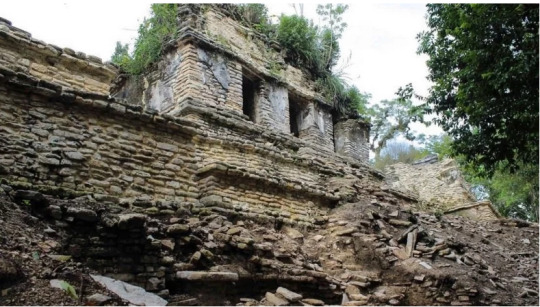
The tragically deceased capital of the Ancient Mayan Kingdom Sak Tz'i showed up in the lawn of a cow-like ranch in Chiapas, Mexico. During the unearthings by archeologists, a tomb comprising of Maya landmarks and pyramid remains were found. The Mayan human progress, which won in the Mesoamerica locale extending from southeast of Mexico to Honduras, El Salvador and Guatemala, has consistently been the focal point of consideration with its grand urban areas, amazing pyramids and strict sanctuaries. Mayas, one of the most exceptional human advancements of ancient times on account of its authority in the fields of workmanship, engineering and arithmetic, has crumpled totally in only 200 years, because of different elements that are as yet unsure today. Charles Golden, humanities educator at Brandeis University, Andrew Archer, bioarchaeologist from Brown University, and a group of analysts from Mexico, Canada, and the U.S. made a significant disclosure that reveals insight into the past of the Ancient Mayan Kingdom. The analysts discovered significant remains that the tragically deceased capital of the Ancient Mayan Kingdom Sak Tz was stowing away in the lawn of a cows ranch in Chiapas, Mexico. Since June 2018, the group has discovered a grave from Mayan landmarks that contain a significant engraving depicting ceremonies, wars, an unbelievable water snake and a downpour god move. Analysts, who have additionally found pyramid ruins, the illustrious castle and the play area, in a similar region, trust that the discoveries will finish a portion of the missing bits of antiquated Maya legislative issues and culture. Sak Tz'i Kingdom, situated on the present-Mexico-Guatemala outskirt, administered in a moderately little area. Those living in the wide open collected a wide assortment of harvests, delivering earthenware and stone instruments. Brilliant and his associates likewise arrived at the remnants of the commercial center where individuals sold these products. In the wake of finding the vestiges of a 45-meter pyramid at the northeastern finish of the city, and different structures utilized for private and strict ceremonies, the group discovered proof that the capital was encompassed by soak walled streams. Expressing that the general population is continually confronting the risk of war, Golden said that they are attempting to dispose of the dangers from different developments with the dividers they fabricated. Specialists will currently utilize LIDAR innovation to comprehend the separation of an item or a surface by laser heartbeats to remove the building structure and geology of the antiquated city. The discoveries to be acquired in the unearthings are relied upon to reveal insight into numerous riddles about Mayan progress. Read the full article
0 notes
Photo

6 Tz'i: Tz'i represents faith, loyalty, sexuality, justice, and unconditional love. 6 represents ultimate stability, the 6 directions (north, south, east, west, the sky, and the earth), and the 6 aspects of family: health, understanding, work, friendship, possessions, and positive & negative action. Today is a good day to put trust in our instincts and faith in life when things may seem rough or we question why we're putting effort and energy into something. Bringing unconditional love to family today may help restore stabilization to our shaken instincts or trust. Tz'i is sometimes referred to as the nawal of sex, drugs, and rock and roll, listening to instincts over reason, and can be as much of a trouble maker as it is faithful. Today may bring up the most positive displays of friendship, but can also be tested by temptation. https://www.instagram.com/p/B6F-EyVDA2o/?igshid=157vzkhomh9u1
0 notes
Photo
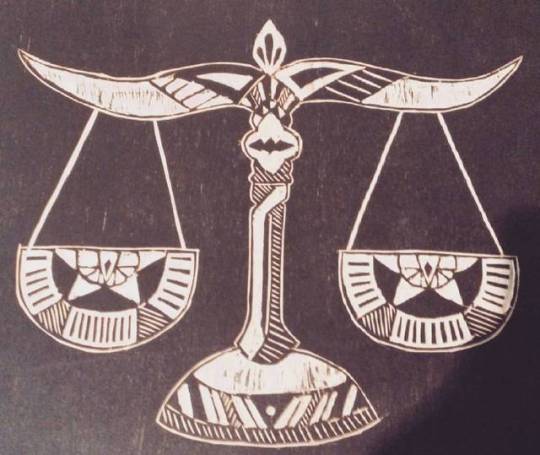
Libra, the Scales. || 7/12 || Aj tz'i b'al. #ajtzibal #thezodiacs #grabado
1 note
·
View note
Text
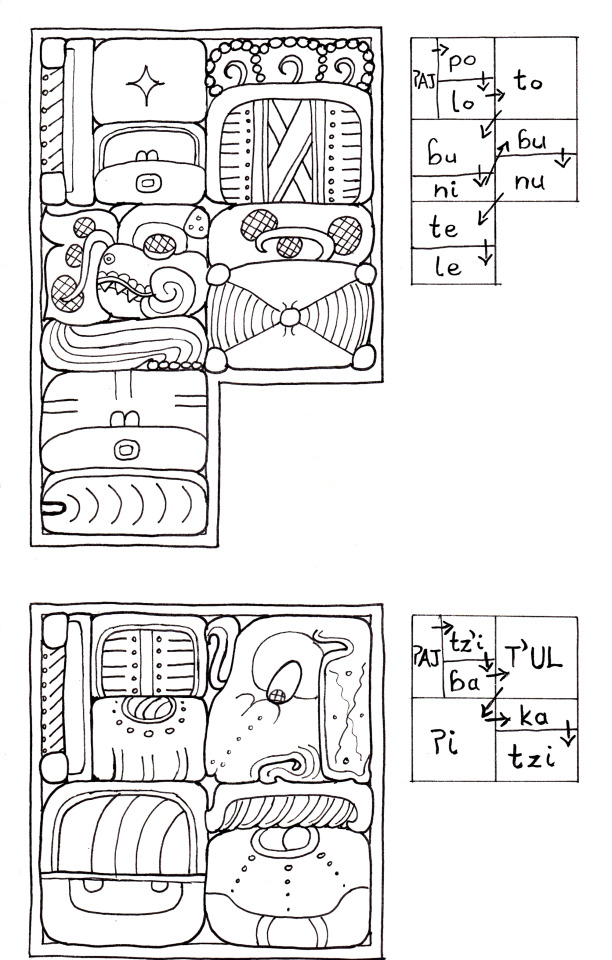
It's my friend, @plotbunny-bundle!
They've been sending me asks, which makes me happy, and I show love by writing things pretty. So I translated their Tumblr name into Classical Maya.
The first phrase is a transliteration. That means I copied the sounds as closely as possible.
ʔɑj polot ɓuni ɓuntel
The 'b's have little curves on the top because they're implosive, which means the sound is made while the air is going in, rather than out.
Glyphs: ʔAJ-po-lo to ɓu-ni ɓu-nu te-le
The second phrase is a translation. I matched the meaning of Bunny's name as well as I could to Classical Maya words:
Scribe Rabbit Bundle
I don't know of a word for 'plot' or 'idea', but Maya mythology does have at least one rabbit scribe, and I felt that might get the idea across. More literal translation:
sir/one.who writes rabbit bundle/tribute
Pronunciation: ʔɑj tz'ihɓ t'ul ʔikɑɑtz
Glyphs: ʔAJ-tz'i-ɓɑ T'UL ʔi kɑ-tzi
11 notes
·
View notes
Text
Mayan Day Signs
Below are the 20 Day Signs for Mayan Astrology. A few good Mayan Astrology calculators: mymayansign.com or tokenrock.com/mayan/tzolkin-calculator/ Know that many names and symbols over lap. If you can't find your sign try researching the Mayan name or symbol. If anyone has information on Mayan astrology please share! There is a lot to dig thru.
Mayan Day Sign: B'atz Symbol: The Monkey Good mediator, artistic, a planner, great advice giver, loves nature, charming, see's the big picture.
Mayan Day Sign: T'z'ikin Symbol: Bird of power Good with money, friendly, giving, problem solver, highly values social status, stable, hard worker.
Mayan Day Sign: Kawoq Symbol: Storm/Family Family-oriented, nurturing, affectionate, gentle, loving, sometimes spiritual, loyal.
Mayan Day Sign: Aq'ab'al Symbol: Dawn/Night/House Optimistic, lucky, persistent, helpful, instinctive, desires admiration and respect, has many friends.
Mayan Day Sign: Kej Symbol: Deer Balanced, harmonious, gentle, ambitious, diplomatic, a good leader and adviser, one with nature, stable.
Mayan Day Sign: E Symbol: Road/Path Takes charge, charismatic, intelligent, a great negotiator, has good business sense, good with money, political.
Mayan Day Sign: Ajmaq Symbol: Wisdom/Curiosity/Owl Investigative, secretive, good luck with health, analytical, logical, reserved, needs to frequently clear their mind.
Mayan Day Sign: Ajpu Symbol: Sun Confident, optimistic, loves a good challenge, lucky, energetic, strong, a good leader, magnetic.
Mayan Day Sign: K'at Symbol: Net Honest, friendly, good luck with family especially children, energetic, determined, communicative.
Mayan Day Sign: Q'anil Symbol: Seed Intuitive, creative, happy-go-lucky, accepting, social, adaptable, easygoing, caring, a good teacher.
Mayan Day Sign: Aj Symbol: Authority/Leader/Ruler/Reed Loyal, loves to research, authoritative, determined, sticks to a moral code strictly, steady, calm.
Mayan Day Sign: No'j Symbol: Knowledge Hates confrontation, overly trusting, honest, intelligent, curious, lives in the mind, all about equality.
Mayan Day Sign: Imox, Symbol: Crocodile Stubborn, a homebody, romantic, passionate, thrives on excitement, lucky, flirty, self-focused.
Mayan Day Sign: Kan Symbol: Snake Passionate, intelligent, athletic, tough, perfectionist, works behind the scenes, magnetic, hates criticism.
Mayan Day Sign: Toj Symbol: Fire Values justice and balance, lucky, outgoing, charismatic, inspiring, warm, hyper, bold, ambitious, strong-willed.
Mayan Day Sign: I'x Symbol: Jaguar Strong, passionate, courageous, full of life, sexy, a dreamer, secretive, a bit unpredictable, aggressive.
Mayan Day Sign: Tijax Symbol: Knife/Flint/Sword Persuasive, a leader, balances intuition with intellect, forward, mature, fixed, vocal.
Mayan Day Sign: Iq Symbol: Wind Devoted, impulsive, passionate, intelligent, changeable, manipulative, imaginative, moody, observant.
Mayan Day Sign: Kame Symbol: Death Intuitive, good listener, emotionally and spiritually strong, people trust them, romantic, sympathetic.
Mayan Day Sign: Tz'i Symbol: Dog Faithful, kind, sensible, adventurous, communicative, easygoing, playful, has many friends and lovers.
160 notes
·
View notes
Text
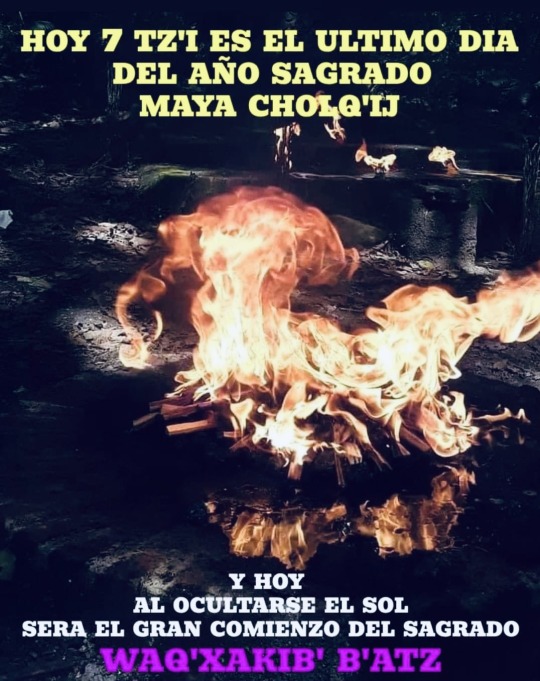
Estimadas hermanos Mayas hoy es 7 TZ'I 19 Q’ij en nuestro sagrado calendario Maya Cholq'ij, hoy es el día 260.
Hoy damos gracias al Creador y Formador por habernos permitido llegar con bien hasta este último día del año sagrado maya.
Y con el favor del Ajaw y del sagrado mundo; hoy a partir de la entrada de la noche daremos inicio a la gran celebración del Waqxakib' B'atz, año nuevo sagrado Maya en la intimidad de nuestros hogares, y en los sagrados Tab'al Tz'ij (Altares sagrados Mayas) todo el día de Mañana.
Sinceramente: WWW.MAYATECUM.COM la fuente de los verdaderos Mayas
Nota: El Waqxakib' B'atz es el tiempo propicio para los Mayas para DAR, para OFRENDAR para que RECIBAN las grandes bendiciones del sagrado Waq'xakib' B'atz en sus vidas. Por eso, si no ha hecho todavía su ofrenda para Waqxakib' B'atz le invitamos a que lo haga ahorita mismo en: https://mayatecum.com/donaciones/
0 notes
Photo

Nahual
Image description here X
Englis text here X
#noe muñoz#tz'i#miraculous ladybug#miraculos oc#miraculous sona#miraculous lady bug#mi miraculous#alfrely#nahual#oc#kwami#wold#lobo#werewolf#my art#wolf kwami#kwami wolf#miraculousona
16 notes
·
View notes
Video
They Finally Found the Capital City of the Maya Kingdom, Sak Tz'i'?
0 notes
Text
Khai quật thành phố Maya cổ đại trong sân trang trại
Các nhà nghiên cứu tìm thấy kinh đô thất lạc của vương quốc Sak Tz'I khi khai quật trang trại chăn nuôi gia súc.
0 notes